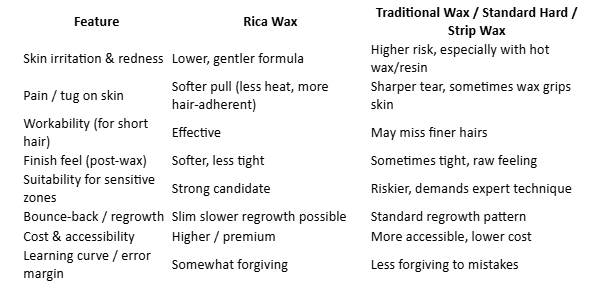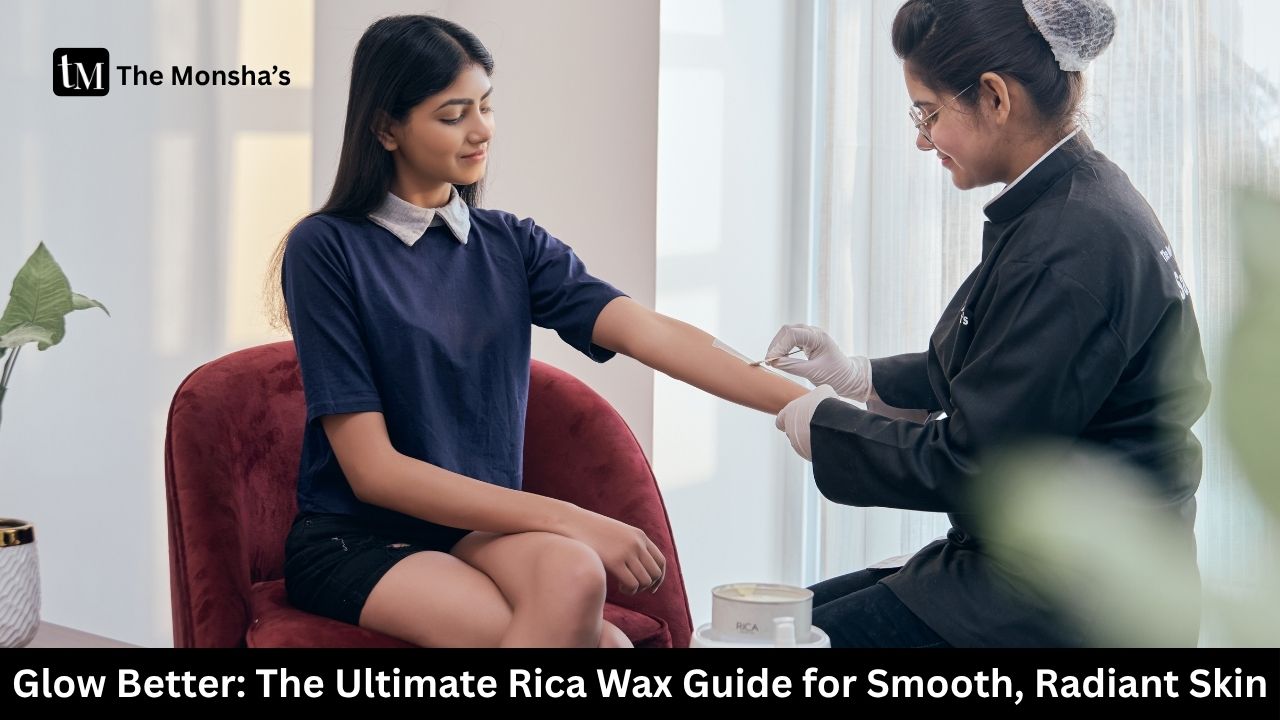TL;DR
If you’re exhausted from red bumps, burns, and uneven waxing, Rica wax might be your skin’s new BFF 😊. Thanks to its gentler, plant-based formula (free from harsh resins), it offers smoother removal, less irritation, and a more nourishing finish. But it’s not magic — your skin type, technique, and aftercare still matter. Keep reading for the ultimate guide so you can wax smart.
1. Let’s Roll
Oof — after one too many waxing sessions that left my legs screaming, I nearly gave up. But then I tried Rica wax, and something shifted (no dramatic overpromise, I promise). Now I want to spill everything I’ve learned: the good, the caveats, how to use it well, and whether it’s truly worth the switch — desi tone, tired beauty blogger style.
In this post, you’ll learn:
- What makes Rica wax different
- Its real benefits (with caveats)
- Who should use it (and when to pause)
- Step-by-step tips + mistakes to avoid
- My verdict (with some skin stories)
- FAQs to clear your last doubts
Let’s glow.
2. What Is Rica Wax?
2.1 Origins & Philosophy
Rica is a professional waxing line (originally from Italy) that focuses on natural, gentle formulations. Its design philosophy: leave skin smooth, not traumatized. Many classic waxes use harsh resins (like colophony) that grip skin along with hair and cause irritation; Rica avoids that.
2.2 Key Ingredients & Technology
- Glyceryl rosinate: a non-allergenic resin alternative that offers adhesion without harshness. (Unlike colophony, which is a known skin irritant)
- Vegetable oils / natural oils / beeswax: moisturize, cushion the skin, and reduce drag.
- Zinc oxide / titanium dioxide: some variants include these for soothing, skin barrier support, and mild brightening / anti-inflammatory effect.
- Liposoluble / low-melt formulas: designed to work at lower temperatures, reducing burn risk.
So, Rica is not “just another wax”; its formulation is built to reduce common pain points of waxing.
3. Rica Wax Benefits (Plus Real Limits)
Let me dish the perks and the things you should be cautious about — transparency is sexy.
3.1 Real Benefits
- Gentler on Skin / Lower IrritationBecause it avoids harsh resins and uses a lower melting point, Rica tends to cause less redness, burning or inflammation — especially for sensitive skin.
- Better for Short / Fine HairIts adhesion is strong enough to catch shorter, more stubborn hairs that many standard waxes may leave behind.
- Moisturizing & Nourishing FinishThe natural oils in Rica help the skin feel softer post-wax (less stripped). Many users say their skin feels more “silky” rather than tight or raw.
- Reduced Bumps / Fewer IngrownsBecause it’s gentler and less traumatic, there is often milder inflammatory response, which may reduce post-wax bumps or ingrown hairs (though not completely eliminate).
- Longer Smooth Periods + Slower RegrowthWith consistent use, some users report hair regrowth slows and becomes finer (follicle weakening over time).
- More Comfort & Safety in Delicate ZonesIn areas like the face, underarms, bikini line (where skin is more reactive), the creamy, low-heat nature of Rica wax gives it an edge.
- Tan / Dead Skin Removal as BonusSome claim that Rica wax helps in mild exfoliation, thereby reducing superficial tanning/dullness.
3.2 Tradeoffs & Caveats
- Cost / Premium PricingBecause Rica is a professional & imported product, salons may charge more. For some users, the skip from standard wax to Rica is a “luxury upgrade.”
- Technique-SensitiveEven with better formulation, mistakes in wax temp, thickness, pull angle, or skin tension will still lead to irritation or incomplete removal.
- Not “Zero Risk”Skin can still be irritated — especially if you have very reactive skin, active acne, open wounds, or are on strong actives (retinoids, AHAs).
- Strips or Tools MatterUsing poor quality strips or reusing wax pots can sabotage benefits no matter how good the wax is.
- Requires Solid AftercareNo formula can completely replace good aftercare — skip it at your peril (bumps, pigment, breakouts).
4. Rica Wax vs Traditional / Regular Wax: Feature Face-Off

Then in real-salon life: even if Rica is “better on paper,” a bad waxer or overheated wax can ruin it. Always check your parlour’s hygiene, wax storage, technique.
5. Who Should Use Rica (and Who Should Pause)?
Let me break it down so you don’t waste your wax bucks.
5.1 Ideal Candidates
- Skin that reacts easily (rosacea, sensitivity)
- Users who’ve struggled with post-wax redness, bumps
- People who prefer premium salon experience
- Those removing hair from delicate zones
- Anyone wanting slower regrowth over repeated use
5.2 Be Cautious / Pause If You Have:
- Active acne / open lesions / eczema or psoriasis in target areas
- Fresh chemical peel / laser / strong retinoid usage (skin barrier compromised)
- Very reactive allergies — always patch test
- Expecting miracle for deep, coarse hair in very first session
5.3 Quick Patch Test (always)
Pick a small, discreet area. Apply wax exactly as would be done. Wait 24 hours. If no abnormal swelling, pustules, prolonged heat — you’re safer to proceed. Always do this.
6. How to Use Rica Wax: Tips, Steps & Blunders to Avoid
Here’s how I’d coach you, tired-beauty-blogger style.
6.1 Before Waxing
- Grow out hair ~2–3 mm (so wax can grip)
- Cleanse skin (non-oil, gentle)
- Light exfoliation a day before (not harsh)
- Avoid strong actives / acids / retinoids 24–48h before
- Inform your waxer of skin sensitivities, medications
6.2 During Waxing
- Warm wax properly — let it reach workable creamy consistency (not scorching hot)
- Apply thinly in direction of hair growth — don’t glob
- Use clean / good quality strips (if using strip version)
- Hold skin taut & pull sharply back, not upward
- Minimal passes — if hair didn’t come, reapply small area rather than multiple passes
6.3 Aftercare
- Immediately soothe with aloe gel, cold compress, or post-wax calming serum
- Avoid sun, heat, sweating, friction for at least 12–24 h
- Don’t apply heavy makeup or harsh ingredients on treated area
- Use gentle moisturizers, and later gentle exfoliation (2–3 days after)
- Keep the skin clean; avoid picking bumps
6.4 Common Mistakes to Avoid
- Wax too hot → burns
- Wax too thick → doesn’t set well
- Pulling in wrong direction or not holding skin → more pain
- Double dipping in wax pot (contamination)
- Skipping strip quality or reusing strips
7. My Stories & User Voices
“I once attempted doing Rica at home and burnt my inner thigh — was too eager to heat up the wax. Switched back to salon for a while before getting comfortable with technique.”
“I used to alternate between regular wax and Rica. After a few sessions, I noticed less redness and my regrowth seemed softer — not sure if placebo, but I kept going.”
“Roll-on Rica wax is a lifesaver in a hostel room — messier but doable.” — (Reddit user)
These stories remind us: good product + bad execution = meh result.
8. Final Thoughts (From a Weary Beauty Nerd)
Rica wax isn’t a magic wand, but it is a smarter upgrade — especially if your skin is already screaming from traditional waxes. Use it with respect: good technique, clean parlour, stellar aftercare. If your skin cooperates, you’ll notice softer recovery, fewer bumps, and maybe even slower regrowth over time.
In the end: test it, see how your skin behaves, and keep a wax journal (date, area, reaction). Trust your skin’s feedback more than any hype.
9. FAQs
Q: Does Rica wax hurt less?
Often yes — many users feel the pull is gentler compared to overheated or harsh waxes, thanks to lower melting formulas and skin-friendly resins.
Q: How long does smoothness last post-Rica waxing?
Typically similar to regular waxing: anywhere between 2–4 weeks, varying by your hair growth speed.
Q: Can Rica wax remove tan / dullness?
It offers mild exfoliation, so superficial tan and dead cells may reduce. But it’s not a substitute for proper exfoliants or treatments.
Q: Can I do Rica at home (DIY)?
Yes — many people do (roll-ons, beads), but the risk of burns or uneven removal is higher. Some users warn inexperienced attempts can go wrong.
Q: How often can I wax with Rica?
As often as your hair cycle allows and your skin recovers — again, 2–4 week intervals are common. Don’t overdo or stress your skin.
Q: Is every salon’s “Rica wax” equally good?
Not at all. The quality, storage, heating, and skill of the therapist matter greatly. Always ask about stock freshness, hygiene, and technique.

